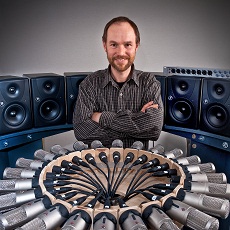Victoria part of international bid to understand hearing defects
27 Mar 2013 - 16:43:05 in Research
A Victoria University researcher’s investigations into improving the diagnosis and treatment of hearing defects will take a leap forward as a result of winning funding from the European Commission.
Dr Paul Teal, a Senior Lecturer in the School of Engineering and Computer Science, is part an international research team that has been awarded €2.9 million (NZ$4.5 million) by the 7th Framework Programme for Research, which funds research and development that creates high quality knowledge.
The team will build a finite element model of the cochlea, a spiral chamber located inside the ear that turns sound vibrations into electrical signals which travel along nerves to the brain and allow us to hear.
Victoria is the only university outside Europe to have a researcher as part of the successful bid. Dr Teal’s inclusion is also exceptional because the Commission, which represents the interests of the entire European Union, usually only pays for collaborators based outside Europe to travel there, but not for their time.
Dr Teal, who receives nearly $188,000 of the funding, was asked to join the team because of his world-leading research into better ways of measuring the cochlear microphonic, which is the electrical signal generated inside the cochlea. His work could lead to the development of new techniques to more accurately assess hearing loss.
The project, which will provide a realistic, three dimensional model of the physics of motion in a working cochlea, involves researchers from six European universities and two European companies, including a team at the world-leading Institute of Sound and Vibration Research at the University of Southampton.
Dr Teal’s input allows electrical components to be added to the model which would otherwise be only mechanical and acoustic. The cochlea project comes under the Virtual Physiological Human (VPH) framework which is developing open source digital data on the entire human body.
Sections of the cochlea have been modelled before but no one has yet developed a complete picture. If the team succeeds, Paul says it will answer a lot of questions. “There is still a lot of dispute about how the cochlea even works. It’s hard to study because of where it is in the body and the complex processes at work.
“The fact that the data will be open source is important. The VPH framework allows observations made in laboratories all over the world to be included and analysed. The models developed as a result of that will ultimately be able to be matched against data about an individual to find out exactly what is taking place with a patient.”
Dr Teal’s research takes advantage of recent advances in electronics to find ways of collecting an electrical signal directly from the cochlea. He says the tests most commonly used to measure hearing loss at the moment are non-invasive and record the sounds the ear produces. “However they don’t define the full spectrum of sounds people hear, and the prescriptions given as a result are based on population averages rather than an individual’s condition.
“My vision is that we will one day be able to hook people up to a device that plays them tones and sounds and gives an automatic read-out on the make-up of the hearing aid they need. “Developing the first, full model of a working cochlea will bring us closer to realising that vision.”
Dr Teal will be working on the project for the next three years.

